A-Z List of European Cities
• Amsterdam
• Antwerp
• Athens
• Barcelona
• Basel
• Berlin
• Bilbao
• Brussels
• Bucharest
• Budapest
• Chantilly
• Cologne
• Copenhagen
• Dresden
• Dublin
• Edinburgh
• Florence
• Frankfurt
• Hague, The
• Kiev
• Krakow
• Lille
• London
• Madrid
• Moscow
• Munich
• Naples
• Oslo
• Otterlo
• Oxford
• Paris
• Prague
• Rome
• Rotterdam
• Stockholm
• Strasbourg
• St Petersburg
• Venice
• Vienna
• Warsaw
• Zurich
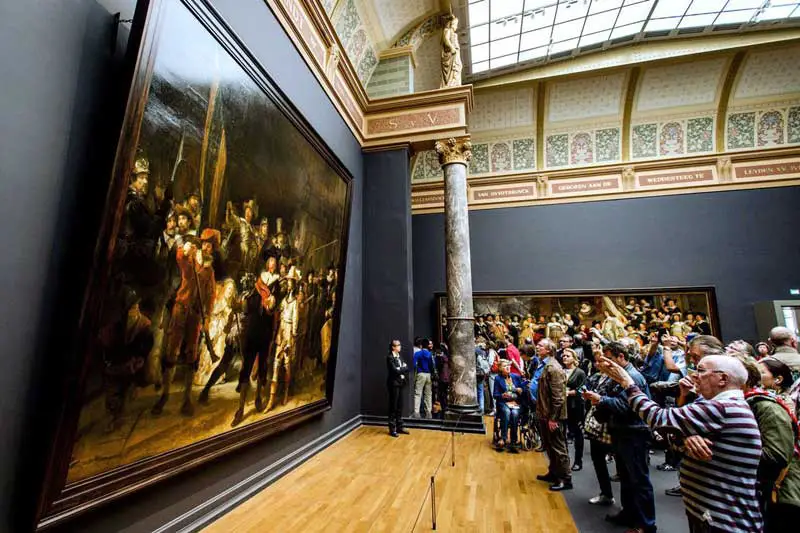
Art Museums in Europe
The galleries on this list hold all types of art, including fine art (like painting, drawing, sculpture, illustration, illuminated manuscripts, icons, engraving, etching, lithography, screen printing), decorative art (armour, ceramics, glass objects, mosaics, tapestry, metalwork, enamelwork, jewellery, lacquerwork, calligraphy, collage), prehistoric art (mainly Neolithic), ancient art (antiquities like bronzes, marbles, friezes) and various types of design. Twentieth century contemporary art is also represented in forms such as: installation, video, animation, and conceptualism. Overall, these collections, several of which were founded by wealthy patrons and art collectors during Renaissance times, represent a selection of the best art museums on the Continent.
Amsterdam, Netherlands
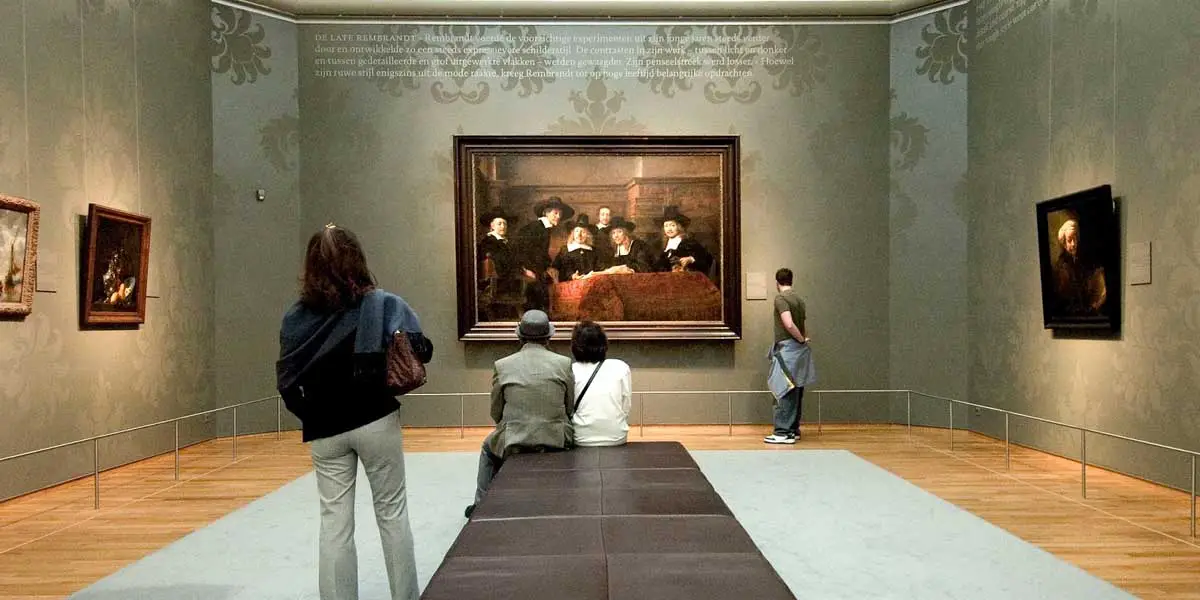
Rijksmuseum
(Amsterdam)
National museum of the Netherlands, containing famous compositions by
Rembrandt, Johannes Vermeer, Frans Hals and other Dutch Realists. The
museum’s print room (Rijksprentenkabinet) contains one of Europe’s
foremost collections of drawings and other graphic art.
Van Gogh
Museum (Amsterdam)
Has the largest single collection of works by the Dutch painter Vincent
van Gogh, and his contemporaries.
Antwerp, Belgium
Antwerp
Museum of Fine Arts
Opened in 1810, the Koninklijk Museum voor Schone Kunsten van Antwerpen
features painting, sculpture and drawing from 1400-2000, with works by:
Jan van Eyck, Jean Fouquet, Roger van der Weyden, Joachim Patinir, Van
Dyck, Frans Hals, Jacob Jordaens, Rubens, James Ensor and other representatives
of Flemish painting.
Athens, Greece
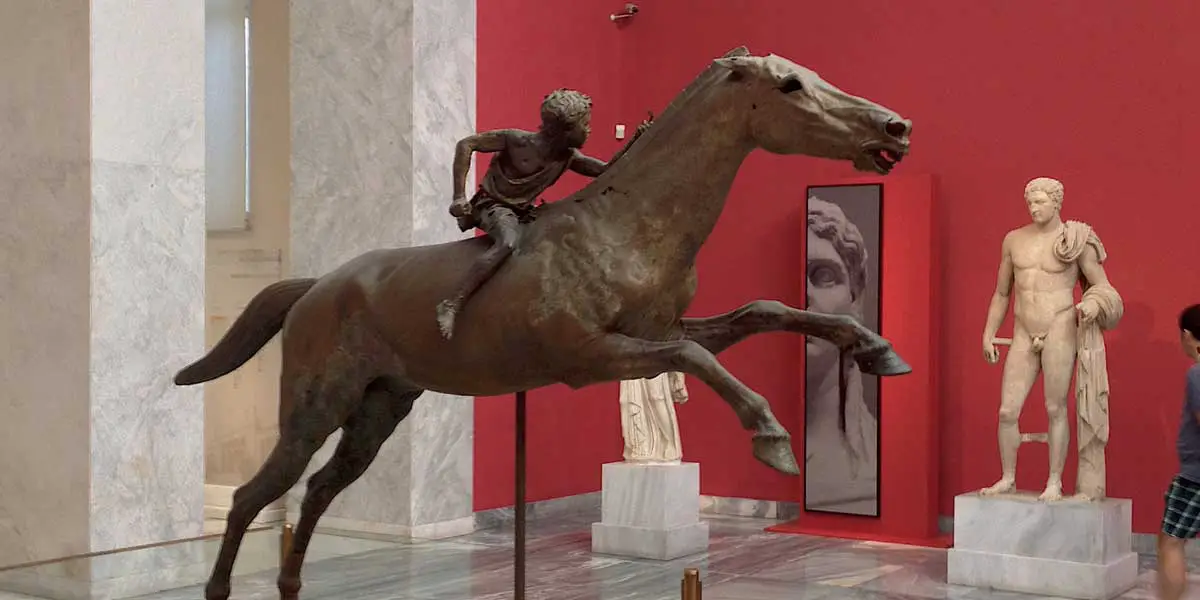
The National Archaeological Museum
(Athens)
Has the world’s richest collection of artifacts and antiquities from Ancient
Greece, including prehistoric Cycladic, and Mycenaean items, ancient Greek
sculpture (statues and reliefs) and pottery, the Stathatos Collection,
the Vlastos Collection, and an assembly of Egyptian artifacts.
Barcelona (Spain)
Picasso Museum (Barcelona) Established by Jamie Sabartes and opened in 1963, it houses some 3,500 items by the 20th century Spanish artist Pablo Picasso, including works from his "Blue", "Rose", "African" and Cubist periods.
Basel (Switzerland)
Kunstmuseum
Basel
Switzerland’s top art museum, its collection
includes masterpieces by Hans Holbein, Mathias Grunewald, Martin Schongauer,
Lucas Cranach the Elder, Konrad Witz, Arnold Bocklin, Ferdinand Hodler
and others. Styles like Cubism, Expressionism, Constructivism, Dadaism
and Surrealism, are also covered, plus American modernism since 1950.
For details of arts fairs like Art Basel and the Berlin Biennale, please see: Contemporary Art Festivals – Top 30.
Berlin (Germany)
Gemaldegalerie
SMPK, Berlin
Based on the personal collection of Frederick the Great, its highlights
include paintings by Lucas Cranach, Albrecht Durer, Raphael, Titian, Caravaggio,
Peter Paul Rubens, Rembrandt and Jan Vermeer.
Guggenheim
Berlin
Designed by Richard Gluckman and opened in 1997, it is small gallery of
avant-garde art in Berlin’s Unter den Linden area, jointly owned by Deutsche
Bank and the Solomon R Guggenheim Foundation.
Neue Nationalgalerie (Berlin)
Has an extensive range of modern 20th century art, featuring movements
like Cubism, Expressionism, the Bauhaus, Surrealism and Abstract Expressionism,
with artworks by Picasso, Ernst Ludwig Kirchner, Joan Miro, Wassily Kandinsky
and Barnett Newman.
Bilbao (Spain)
Guggenheim
Bilbao
Designed by the Canadian-American architect Frank Gehry, the museum opened
in 1997 to promote avant-garde works through permanent and temporary exhibits
by top contemporary artists, from Spain and overseas.
Brussels (Belgium)
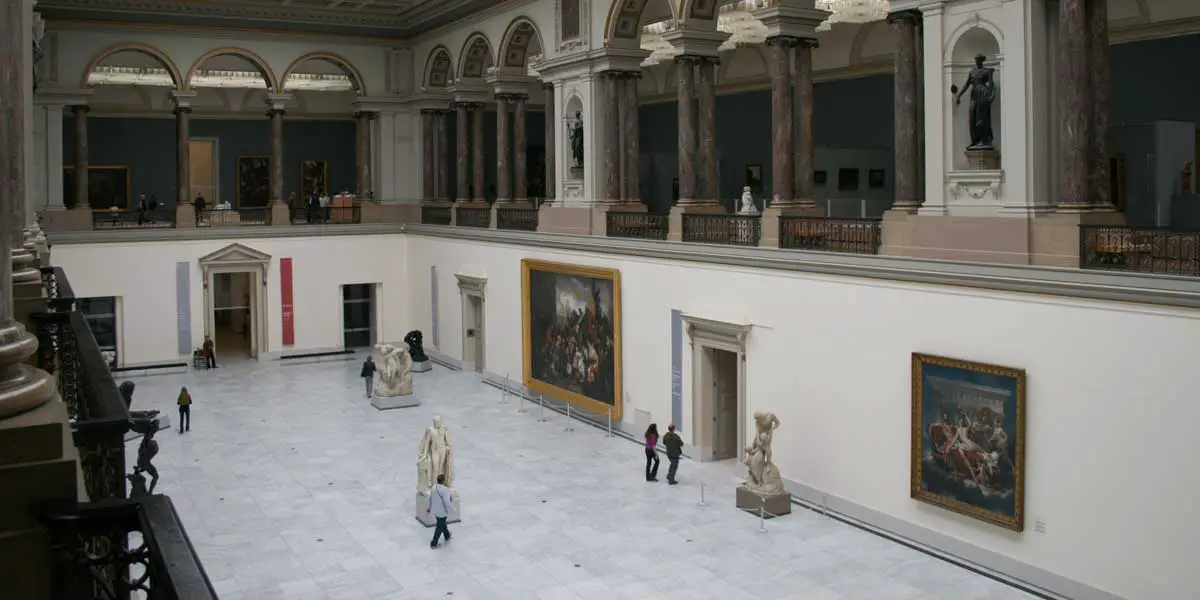
Royal Museums of Fine Arts (Musees
Royaux de Beaux-Arts) (Brussels)
Includes the Museum of Ancient Art, the Museum of Modern Art, the Museum
Constantin Meunier and the Antoine Wiertz Museum. The permanent collection
has 20,000 items, including works by Flemish
painters like Robert Campin (the Master of Flemalle), Pieter Brueghel
the Elder, Jacob Jordaens, Rubens and Frenchman Jacques-Louis David.
Bucharest (Romania)
National Museum of Art (Bucharest)
Completed in 1937, Romania’s National Museum is housed in the former royal
palace in Revolution Square, central Bucharest. It contains important
collections of medieval and modern Romanian art, as well as collection
of international artworks collected by the Romanian royal family. Highlights
include sculptures by Constantin Brancusi, paintings by Nicolae Grigorescu,
Gheorghe Tattarescu, and others, as well as works by Old Masters such
as Jan van Eyck, Rubens, Rembrandt, Domenico Veneziano, Antonello da Messina,
El Greco, Tintoretto, Claude Monet and Alfred Sisley.
Budapest (Hungary)
Museum of Fine Arts (Budapest)
Opened in 1906, Szepmuveszeti Muzeum is organized around six departments:
Egyptian, Greek and Roman Classical Antiquities, Sculpture, Old Masters,
the Modern Collection, and Prints/Drawings).
Chantilly (France)
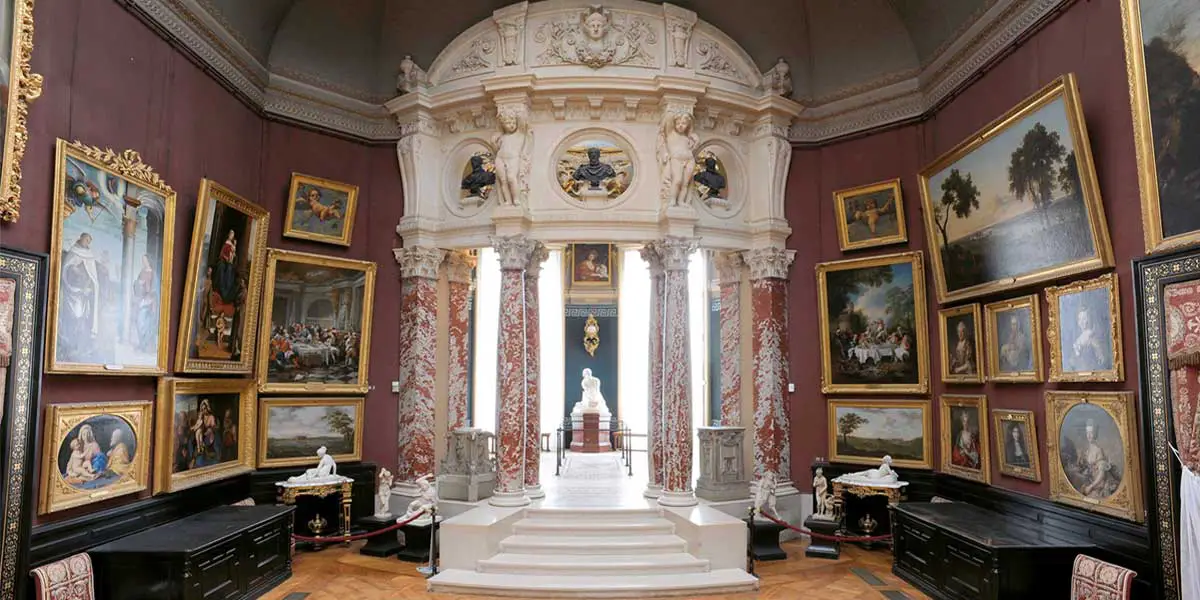
Musee
Conde Chantilly
One of the best art museums in Europe, the Musee Conde (housed in the
Chateau de Chantilly) is one of the finest galleries of medieval
art in France. Its collection features French paintings and book illuminations
of the 14th, 15th and 16th centuries, as well as many Old Masters from
the Renaissance, Baroque and Rococo eras. The library holds some 1300
manuscripts and 12,500 printed volumes, including a Gutenberg Bible, and
some 200 medieval manuscripts. Highlights include the Registrum Gregorii
(983), the famous Les Tres Riches Heures du Duc de Berry and miniatures
from the Book of Hours of Etienne Chevalier, by Jean Fouquet.
Cologne (Germany)
Wallraf-Richartz
Museum (Cologne)
One of the three major museums in Cologne, Germany, its collection features
exceptional works of the Gothic period (eg. by Stefan Lochner) the Northern
Renaissance (Hieronymous Bosch), Baroque (Bartolome Esteban Murillo),
17th-Century Dutch Realism (Frans Snyders, Willem Kalf) Impressionism
(Monet, Renoir, Berthe Morisot), Symbolism (Ferdinand Hodler), 20th-Century
Photorealism (Richard Estes) and many others.
Copenhagen (Denmark)
State Art Museum (Statens Museum
for Kunst) (Copenhagen)
The Danish National museum whose permanent collection includes Old Masters
like Mantegna, Titian, Tintoretto, Pieter Bruegel, Frans Hals, Rembrandt
and Rubens.
Dresden (Germany)
Gemaldegalerie
Alte Meister Dresden
One of ten venues which make up the Staatliche Kunstsammlungen Dresden
(State Art Collections), its collection features 700 masterpieces of fine
art painting from the 15th to the 18th century, such as the
Sistine Madonna by Raphael; The Tribute Money by Titian;
and Girl Reading a Letter at an Open Window by Vermeer.
Dublin (Ireland)
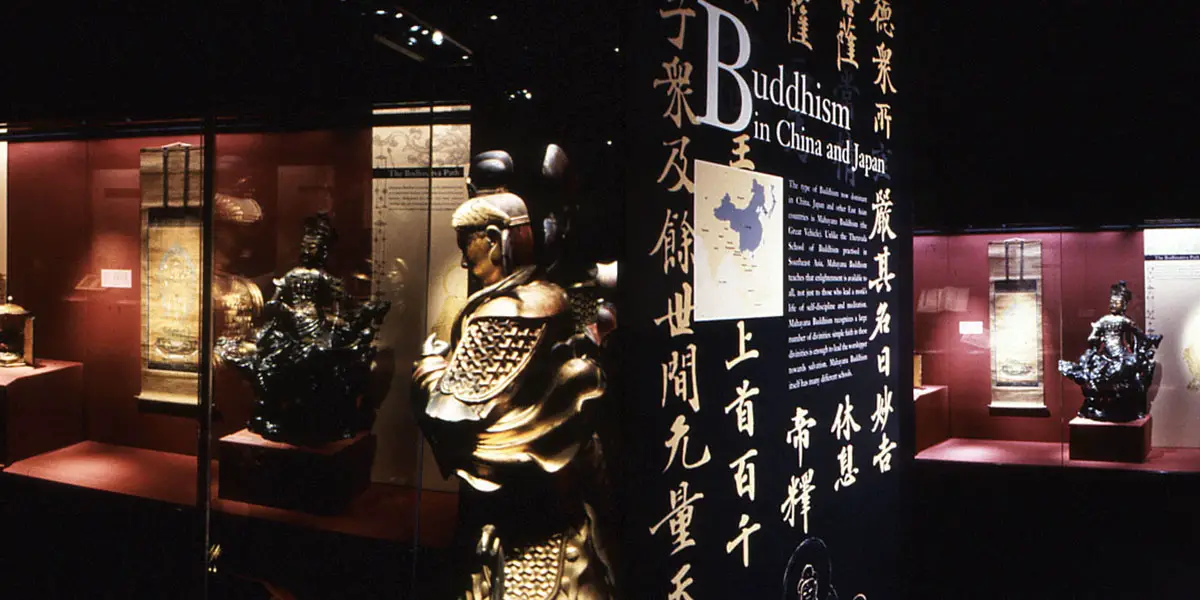
Chester
Beatty Library (Dublin)
One of the finest compact art museums in Europe, opened in 1950, it houses
the collection of Sir Alfred Chester Beatty, of rare manuscripts, drawings,
miniature painting,
prints and decorative arts exemplifying the great cultures of the world.
Hugh
Lane Gallery (Dublin)
Founded by Hugh Lane, it is Ireland’s leading museum of 19th-Century and
early/mid 20th-Century art. Includes an exact reconstruction of Francis
Bacon’s Reece Mews studio in London.
Trinity
College Dublin Library
Holds a unique collection of rare manuscripts including the Book of
Kells (800).
Edinburgh (Scotland)
National
Gallery of Scotland (Edinburgh)
Opened in 1859, the museum is the national gallery of Scotland. Masterpieces
on display include: Virgin Adoring the Sleeping Christ Child by
Sandro Botticelli, Dedham Vale by Constable, The Hon. Mrs Graham
by Thomas Gainsborough, The Vision after the Sermon by Paul Gauguin,
a series of works by JMW Turner, among many others.
Florence (Italy)
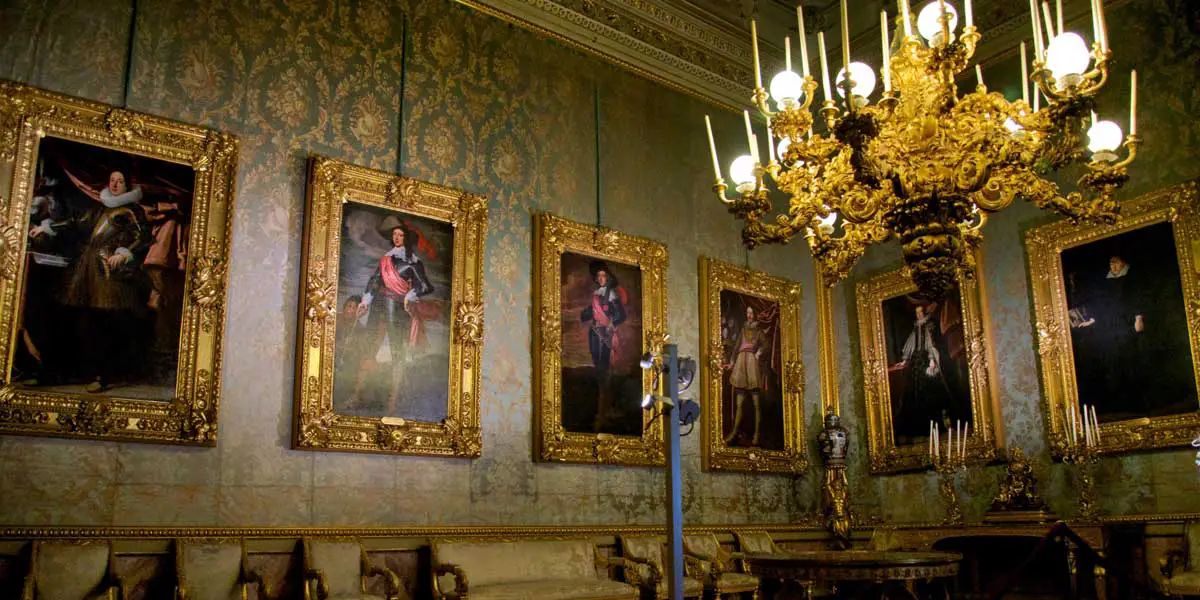
Pitti
Palace Florence (Palazzo Pitti)
The palazzo – known as the Pitti Palace – is a substantial Renaissance
palace situated on the south bank of the River Arno, close to the Ponte
Vecchio. Now the largest museum complex in Florence, its Palatine Gallery
contains more than 500 mostly Early and High Renaissance paintings, which
originally belonged to the Medici family collection. Includes masterpieces
by Raphael, Titian, Perugino, Correggio, Rubens, and Pietro da Cortona.
The Pitti Palace is one of the greatest Renaissance museums in Europe.
Uffizi
Gallery (Florence)
One of Europe’s oldest and greatest art museums, it has the world’s finest
collection of Italian Renaissance art.
Frankfurt (Germany)
Stadelsches Kunstinstitut und Stadtische
Galerie (Frankfurt)
Founded in 1818, the museum owns 2,700 paintings, plus 100,000 drawings,
prints and other works on paper, and over 500 sculptures.
The Hague (Netherlands)
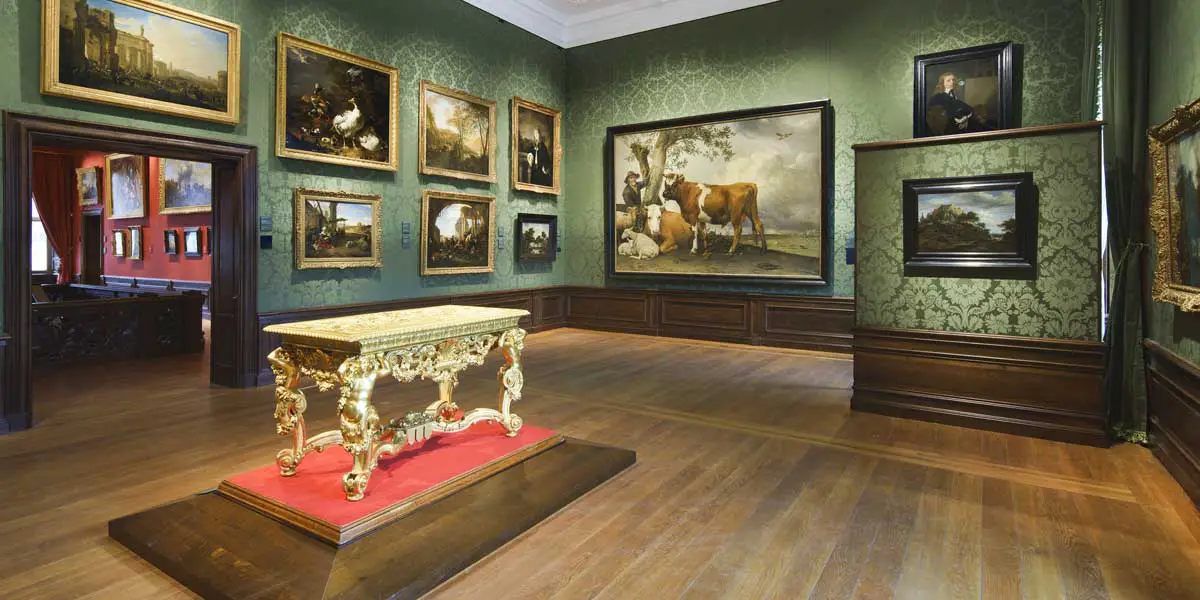
Mauritshuis
Royal Picture Gallery (The Hague)
Specialises in oil paintings from the Dutch Golden Age, by Old Masters
including Jan Vermeer, Rembrandt van Rijn, Jan Steen, Paulus Potter and
Frans Hals. Highlights include Anatomy Lesson of Dr. Nicolaes Tulp
by Rembrandt, and Girl with a Pearl Earring by Vermeer.
Kiev (Ukraine)
Museum of Western and Oriental Art
(Kiev)
Formerly ranked third after the State Hermitage in St Petersburg and the
Pushkin Museum of Fine Arts in Moscow, the museum’s collection of decorative
art, painting and sculpture encompasses Egyptian
and Greek antiquities, Byzantine art and icons, Italian Maiolica pottery,
Meissen porcelain, Persian Ceramics and Bronze sculpture, Chinese pottery,
and much more.
Krakow (Poland)
Czartoryski Museum (Krakow)
Founded in 1796 by Princess Izabela Czartoryska, it contains Lady with
an Ermine, by Leonardo da Vinci, Portrait of a Young Man by
Raphael (later stolen). Other highlights include Greek vases, Roman and
Egyptian antiquities, and Limoges enamels.
Lille (France)
Palais des Beaux-Arts (Lille)
Founded in 1809, with the second largest art collection in France after
the Louvre. It contains Antiquities, Gothic, Renaissance and Baroque art,
as well as modern and contemporary painting and sculpture.
London (Britain)
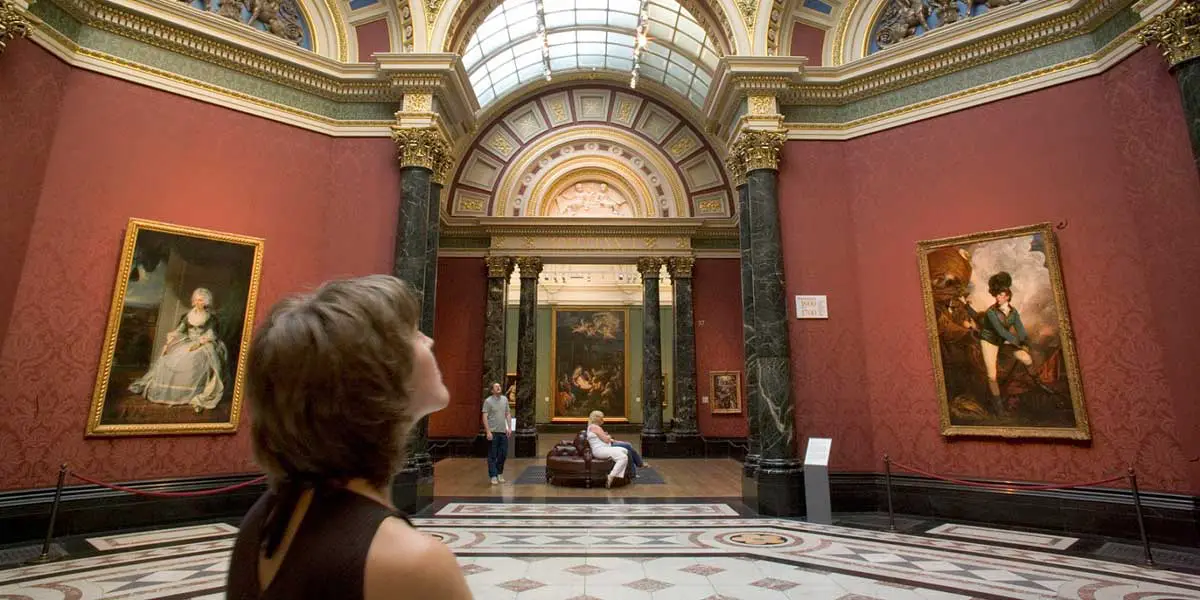
British
Museum
Established in 1753, it is one of the most comprehensive art museums in
the world. Its permanent collection consists of more than 8 million antiquities
and cultural art objects.
Courtauld
Institute Gallery
Founded by Samuel Courtauld, it houses a magnificent collection of Impressionist,
Post-Impressionist, Fauvist and Expressionist paintings.
National
Portrait Gallery London
Houses the world’s largest collection of portraiture (200,000 portraits).
British
Royal Collection
One of the best private art museums in Europe, this collection, amassed
by the Kings and Queens of England, contains almost 50,000 paintings and
drawings, together with 150,000 old master prints.
Saatchi
Gallery
Established by the Iraqi-born British collector Charles Saatchi, it is
Britain’s foremost museum of contemporary art.
Tate
Gallery (London)
Established by Sir Henry Tate, it comprises the Tate Britain (founded
1897), as well as Tate Modern (opened 2000), Tate Liverpool (opened 1988),
and Tate St Ives (opened 1993). The Tate Collection features over 66,000
works.
Victoria
and Albert Museum (London)
Has the world’s most extensive collection of decorative art and design.
The brainchild of Prince Albert, husband of Queen Victoria.
Madrid (Spain)
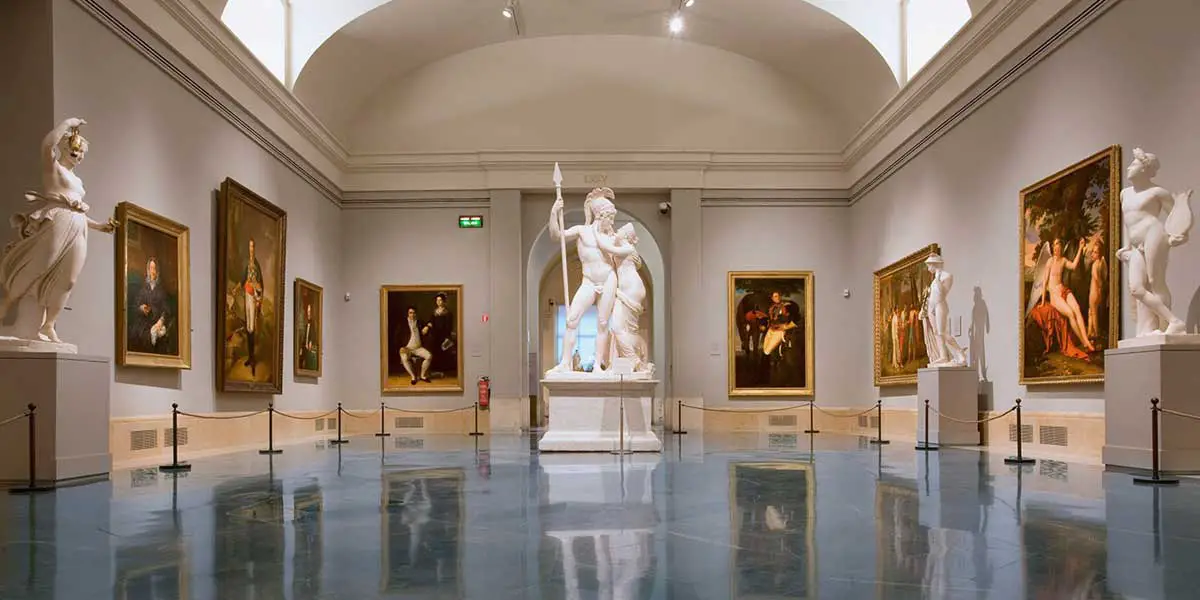
Prado
Madrid
World’s most extensive assembly of Spanish
painting, by Old Masters like: El Greco, Diego Velazquez, Bartolome
Esteban Murillo, Jose de Ribera, Francisco de Zurbaran. Established by
King Charles III of Spain in 1785. It is one of the best art museums in
Europe.
Reina
Sofia Madrid
Spain’s national museum of 20th century art (usually known as The Sofia)
contains important collections of Spain’s two leading 20th century masters,
Pablo Picasso and Salvador Dali, including the iconic Guernica, plus works
by: Juan Gris, Joan Miro, Eduardo Chillida, Antoni Tapies and others.
Thyssen Museum
Has an important collection of 14th-Century and 15th-Century Italian paintings
by Duccio di Buoninsegna and his contemporaries, as well as Netherlandish
Renaissance painters. Baroque and late-19th early 20th-Century styles
are also featured.
Moscow (Russia)
Pushkin
Museum of Fine Arts (Moscow)
Organized by Ivan Vladimirovich Tsvetaev and opened in 1912, this is the
largest Moscow collection of European fine art. It contains works by Impressionist
and Post-Impressionist artists, including Van Gogh, Gauguin, Picasso,
and Matisse.
Tretyakov
Gallery Moscow
Founded by Pavel Tretyakov, it contains the world’s greatest holding of
Russian icons, and Russian art.
Munich (Germany)
Pinakothek
Munich
One of the best art museums in Europe, the complex comprises three major
art galleries in Munich’s Kunstareal: The Alte Pinakothek
(Old Masters to 1700), The Neue Pinakothek (1700-1900), and
The Pinakothek der Moderne (20th Century).
Naples (Italy)
Capodimonte
Museum, Naples (Museo Nazionale di Capodimonti)
This palace houses the magnificent Farnese art collection, including classical
Roman, monumental sculpture, an outstanding collection of porcelain and
majolica, and much more.
Oslo (Norway)
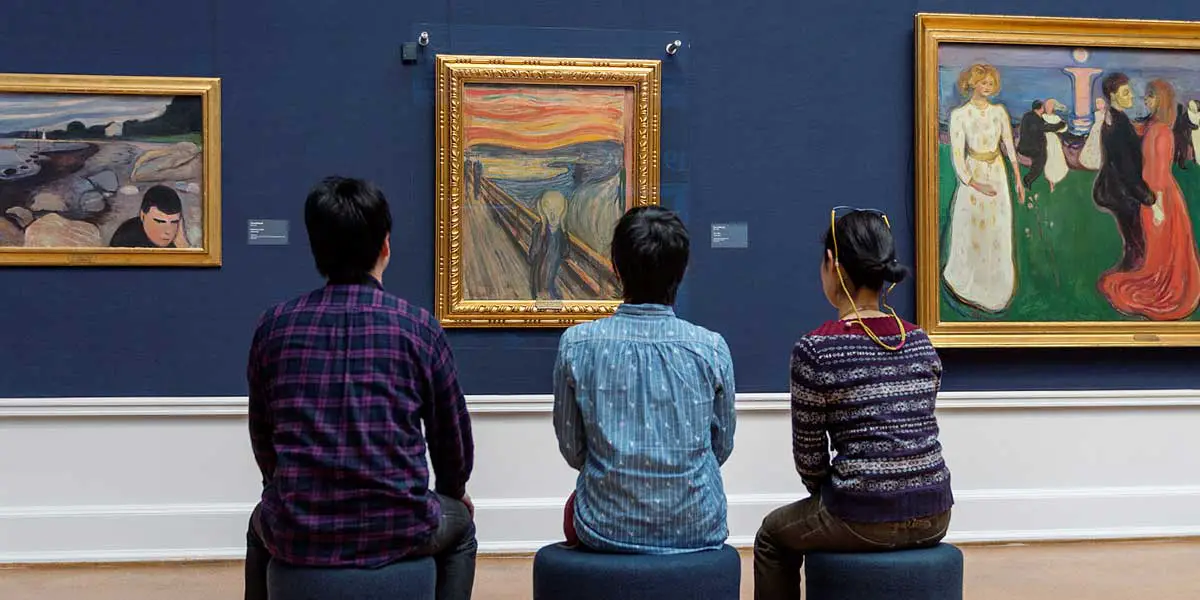
National Museum of Art, Architecture
and Design (Oslo)
Established in 2003 following a merger of the Norwegian Museum of Architecture,
the Museum of Decorative Arts and Design, the Museum of Contemporary Art,
the National Gallery of Norway, and the National Touring Exhibitions,
its permanent collection features works by all important Norwegian artists,
notably Edvard Munch.
Otterlo (Netherlands)
Kroller-Muller
Museum (Otterlo)
Located in the Hoge Veluwe National Park, this art museum and sculpture
garden holds the second-largest collection of Van Gogh paintings in the
world (after the Van Gogh Museum in Amsterdam), as well as works by Lucas
Cranach, Paul Gauguin, Odilon Redon, James Ensor, Georges Seurat, George
Braque, Piet Mondrian, Juan Gris, and Pablo Picasso. Its sculpture collection
features works by Auguste Rodin, Henry Moore, Jean Dubuffet, Lucio Fontana,
Mark di Suvero, Claes Oldenburg and many other sculptors.
Oxford (UK)
Ashmolean Museum of Art and Archeology
(Oxford)
The world’s first university museum, dating from 1678, its highlights
include: Hunt in the Forest (1470) by Paolo Uccello, drawings by Leonardo
da Vinci, Raphael and Michelangelo, Watercolours by Turner, The Arthur
Evans Minoan collection of antiquities, and much more.
Paris (France)
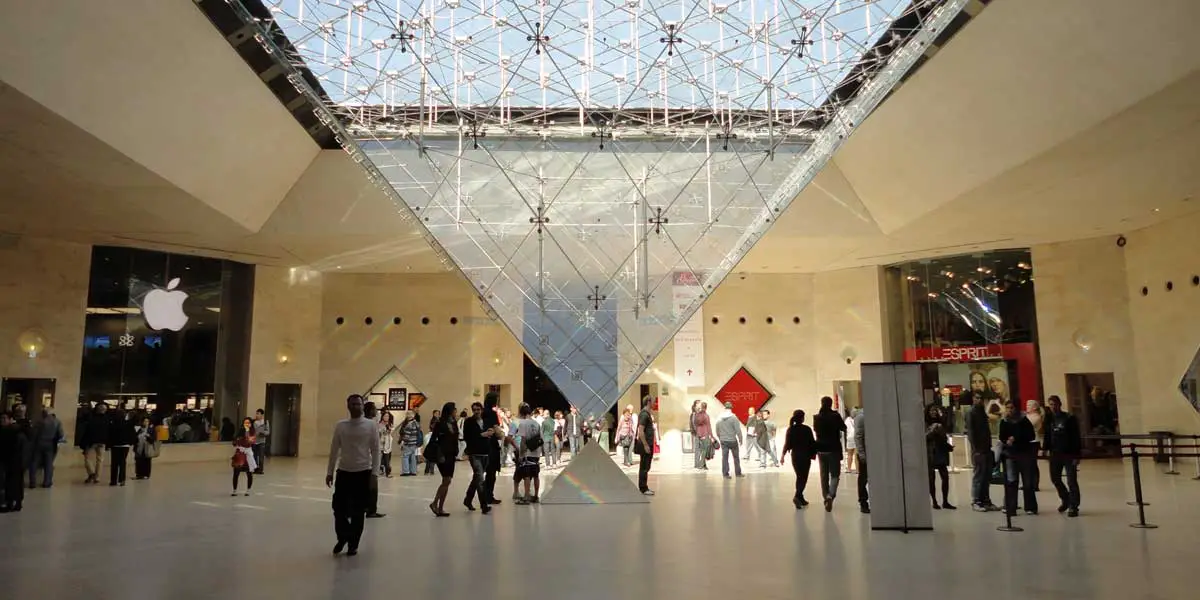
Louvre
(Paris)
The greatest art museum in Europe, it possesses one of the world’s greatest
collections of ancient, classical, Renaissance and French art.
Musee de l’Orangerie (Paris)
Located on the bank of the Seine in the old orangery of the Tuileries
Palace on the Place de la Concorde, it specializes in Impressionist and
Post-Impressionist paintings. (Since 1965, it has been the home of the
famous collection of the late Paul Guillaume.) Artists represented mostly
include members of the Ecole de Paris, like Cezanne, Matisse, Modigliani,
Monet (Nympheas, 1920-26), Picasso, Renoir, Henri ‘Le Douannier’ Rousseau,
Chaim Soutine, Sisley and Utrillo, and others.
Musee Marmottan Monet (Paris)
Situated in the XVIe arrondissement, its collection includes the world’s
largest holding of paintings by Claude Monet, plus works by other Impressionist
and Post-Impressionist painters including, Morisot, Degas, Manet, Sisley,
Pissarro, Gauguin, Paul Signac and Renoir. It also holds the Wildenstein
Collection of illuminated manuscripts.
Musee
d’Orsay (Paris)
Arguably the best museum of 19th century French art in Europe, with the
finest collection of masterpieces by French Impressionist and Post-Impressionist
painters.
Pompidou
Centre (Paris)
Known for its world famous collection of 20th century avant-garde works,
it is one of the best galleries of contemporary
art in Europe.
Prague (Czech Republic)
Narodni Galerie (Prague)
The Czech National Art museum includes a wide range of fine art by Czech
painters and sculptors, as well as Western paintings by Albrecht Durer
and others.
Rome (Italy)
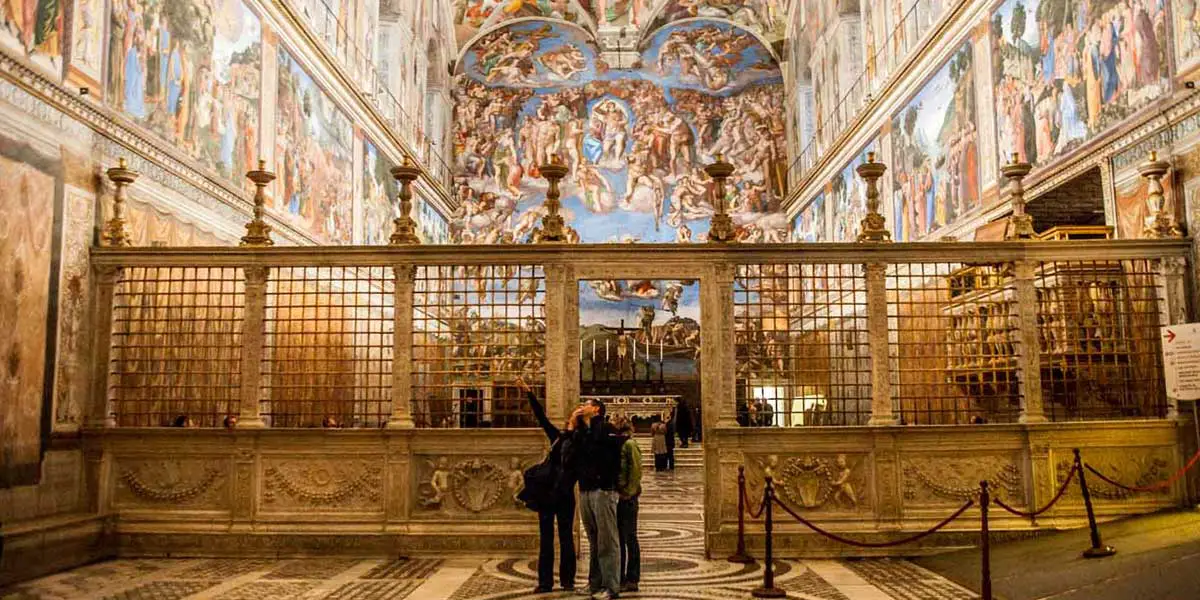
Sistine
Chapel Frescoes (Vatican)
Wall and ceiling paintings by Michelangelo (Genesis Fresco and
Last Judgmenf Fresco), plus others by Botticelli, Domenico Ghirlandaio,
Cosimo Rosselli, Luca Signorelli, Pietro Perugino and Pinturicchio.
Borghese Gallery (Rome)
Contains a significant part of the Borghese collection of Classical Antiquities,
paintings, and sculptures, assembled by Cardinal Scipione Borghese, the
nephew of Pope Paul V (1605–1621). Highlights include paintings by
Caravaggio and sculptures by Bernini.
Doria
Pamphilj Gallery (Rome)
Paintings, furniture and sculpture assembled by the Doria, Pamphilj, Landi
and Aldobrandini families, exemplified by Portrait of Innocent X
(Cardinal Giovan Battista Pamphilj) by Velazquez.
Raphael
Rooms (Vatican)
Papal apartments decorated by the High Renaissance genius Raphael.
Vatican
Museums
One of the best art museums in Europe, it houses the priceless collection
of painting, Italian Renaissance sculpture
and antiquities assembled over the centuries by the Catholic Church.
Rotterdam (Netherlands)
Museum Boijmans Van Beuningen (Rotterdam)
Established in 1847 by Frans Jacob Otto Boijmans, it is the principal
art gallery in Rotterdam, containing masterpieces by Hieronymus Bosch,
Pieter Brueghel the Elder, Rembrandt and Salvador Dali.
Stockholm (Sweden)
Nationalmuseum (Stockholm)
Founded in 1792, its collection includes 500,000 drawings from the Middle
Ages to 1900, along with a variety of porcelain, painting and sculpture.
Strasbourg (France)
Strasbourg
Museum of Fine Arts (Musee des Beaux-Arts)
Permanent collection highlights include works by Giotto di Bondone, Carlo
Crivelli, Piero di Cosimo, Cima da Conegliano, Correggio, Guercino, and
Canaletto; and Netherlandish paintings by Hans Memling, Gerard David,
Maarten van Heemskerck and Pieter de Hooch.
St Petersburg (Russia)
Hermitage
State Museum (St Petersburg)
Founded by Catherine the Great, the Hermitage is one of the world’s largest
art museums.
Venice (Italy)
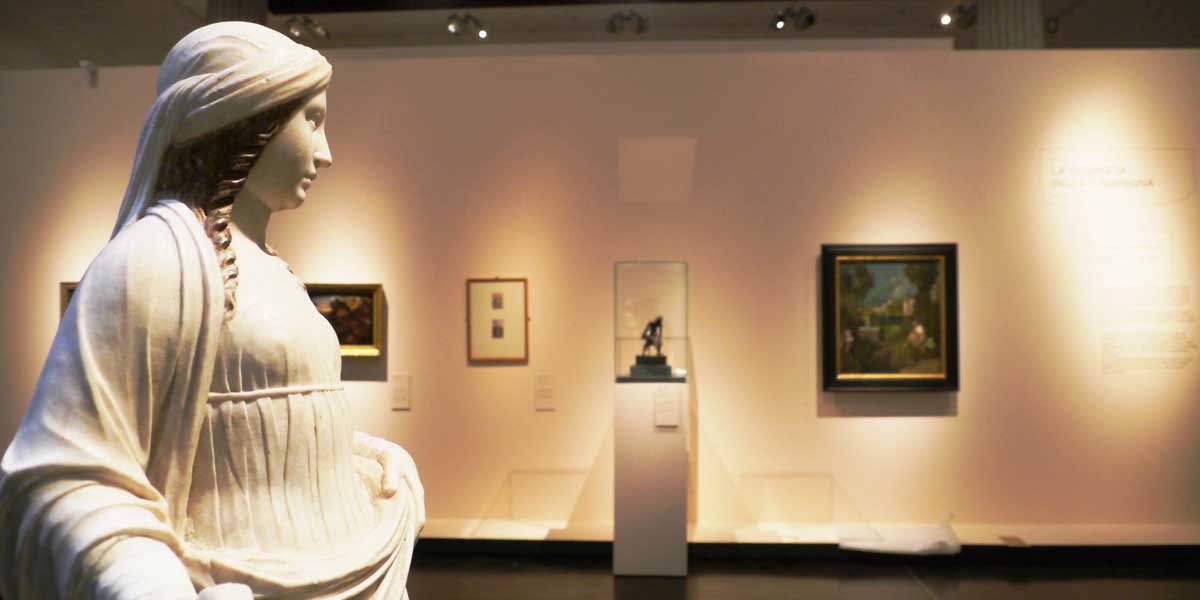
Venice
Academy Gallery (Galleria dell’Accademia di Venezia)
Houses numerous masterpieces of Venetian
painting, including works by Giovanni Bellini (1430-1516), Giorgione
(1477-1510), Titian (c.1488-1576),
Jacopo Tintoretto (1518-1594) and Paolo Veronese (1528-1588).
Peggy
Guggenheim Museum, Venice
Founded by Peggy Guggenheim, it is famous for its collection of 20th century
modernism, featuring works of Cubism, Surrealism and Abstract Expressionism.
Vienna (Austria)
Kunsthistorisches
Museum Vienna
Its picture collection is founded on the collections of three Habsburg
art collectors – Archduke Ferdinand II (1529–1595), Emperor Rudolf
II (1552–1612) and Archduke Leopold Wilhelm (1614–1662). Also
contains the largest holding of works by Pieter Bruegel the Elder.
Warsaw (Poland)
National Museum (Warsaw)
Contains some 780,000 items including works by Botticelli, Rubens and
Rembrandt. Polish artists include: Jozef Chelmonski, Aleksander Gierymski,
Jan Matejko, Jozef Mehoffer, Jacek Malczewski, Stanislaw Wyspianski, Henryk
Siemiradzki, and many others.
Zurich (Switzerland)
E.G. Buhrle Foundation, Kunstmuseum
(Zurich)
Home to an outstanding collection of French Impressionism and Post-Impressionism.
Design by W3layouts
